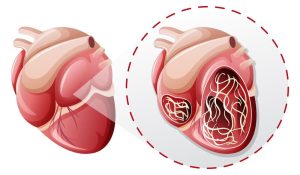The month of February is by far the sweetest of them all, when loved ones are celebrated and we share our heart with others. It also gives us glimpses into the Springtime that is promised. Days become incrementally longer and temperatures might even increase a smidge. If you’re lucky, you may be graced by the site of a robin late in the month.
Despite the cold, sunny days find us all daydreaming of summer vacations, green grass and a vibrant landscape buzzing with all that spring and summer can offer us. Could there be a better month to discuss heartworm disease in your pets, the ones you love with all your heart, than February? We think not.
Heartworms cause a disease most pet owners have a basic familiarity with, as advertisements for preventative medications are prominent in media and social networking platforms. Knowing more about the disease is always helpful, and this is your guide towards a basic understanding of Heartworm disease, what it is, the harm it can cause to your pet and how to prevent it in the first place.
 Keep your pets heartworm free.
Keep your pets heartworm free.
Heartworm disease is found in numerous parts of the world and the disease has been reported in every state in the US. The disease itself is caused by worms that reside in the host’s heart and cause damage to the heart, lungs and other organ systems. Adult heartworms can mature to one foot in length. Early detection and treatment are essential to recovery. Untreated, affected animals will succumb to heart and respiratory failure due to the path of destruction left by the parasite.
Even after treatment, however, the lasting damage to the heart and lungs may result in tremendous loss of quality of life for an affected animal. Therefore, prevention is key and considered the main defense against the disease. Heartworm disease affects companion animals including dogs, cats and ferrets. Wild animals such as wolves, foxes and coyotes also harbor the parasite supporting a reservoir for disease in the natural environment.
How is Heartworm disease spread?
Heartworm disease is transmitted by mosquitoes. When a mosquito takes a blood meal from an infected animal it will ingest “baby heartworms” (microfilaria) from that animal’s blood. In 10-14 days, these microfilariae mature into infective larvae in the mosquito. After the 10-14 day period of maturation, if the mosquito feeds on other dogs, cats or heartworm susceptible animals, the larvae can “infect” the pet after the mosquito injects the maturing larvae into the animal’s skin.
Dogs are considered a natural host for heartworms while cats are considered atypical hosts for the parasite. Due to this fact, heartworm disease will act differently in each species. Infective larvae injected into a dog by the mosquito have a very good chance of maturing into adult heartworms over the next 6 months. Mature adult worms mate and produce offspring, their immature offspring (microfilaria) circulate throughout the blood only to be picked up by a mosquito and the cycle starts over in another host. Adult worms may live 5-7 years in a dog, you can only imagine the number of “baby worms” they could produce in their lifetime in an untreated dog that is not on preventative medications.
In cats, atypical hosts, larvae rarely survive, mature or mate. In fact, cats infected with heartworm disease may only suffer from infection of 1-3 adult worms. Sadly, the inflammation can be caused by just a few worms. Eeven larvae alone can still wreak havoc on the cat’s heart and lungs.
 What are the signs of Heartworm disease in dogs and cats?
What are the signs of Heartworm disease in dogs and cats?
Early on in the course of the disease dogs may show very few signs. Especially those “couch potato” types who do not exert themselves with any regularity. In most dogs, signs start with a mild cough and fatigue. Active dogs may not be able to run as far or fast and may not even want to chase a ball. Some dogs have a poor appetite and gradually all dogs begin to lose weight. As the disease progresses full-blown signs of heart failure including a swollen belly, difficulty breathing, and collapse are seen.
Cats may have subtle or unusual signs such as periodic vomiting or weight loss. Cats may present as if they have asthma with a cough and increased respiratory effort or even with seizures and fainting. Signs of heart failure such as fluid accumulation in the abdomen are possible in advanced disease.
An ounce of prevention is worth a pound of cure.
Believing your pet is at zero risk of the disease because you live in a cooler environment is just not true in North America. Also, indoor pets are still at risk of the disease as well. I’m sure we have all experienced at least one summer night trying to fall asleep only to find a mosquito buzzing around your air-conditioned bedroom because it snuck in through a door or window! There are so many options for prevention available to us that no pet should be left without this potentially lifesaving and simple intervention.
There are many extremely safe oral, topical or injectable options for heartworm prevention in dogs and cats. A standard favorite has been the monthly chewable Heartgard© product that is safe for all dogs and cats and comes in a flavored chewable treat that dogs and even cats enjoy. Other oral medications such as Simparica Trio© combine the added benefit of flea, tick and heartworm prevention in a single, tasty chewable treat that is given monthly (for dogs only). Topical products such as Revolution© are safe for dogs and cats and give monthly protection against not only heartworm disease but certain gastrointestinal parasites, fleas, some species of ticks as well the mange mite and ear mite. And finally, perhaps the most convenient option of all (for dogs only) is the once-yearly injectable ProHeart 12© that provides 12 months of heartworm prevention in a yearly injection administered by your veterinarian.
Annual Heartworm testing at Longwood Vet Center saves lives!
Essential to the management of heartworm disease is yearly heartworm disease testing. Heartworm testing involves taking a few drops of blood from your pet and testing for two things 1) the presence of microfilaria in the blood and 2) identifying antigens from adult female worms in the blood. As cats with heartworm disease often do not have live adult worms in their body, testing for heartworm disease in cats is more difficult. Even if your dog is on heartworm preventative monthly, it is very important to test yearly to confirm the effectiveness of treatment. Giving pills late or missing a few months of preventative will put your dog at risk.
Heartworm disease is an important topic that deserves a significant amount of discussion for you, our clients, to better understand the ins and outs of the disease, its prevention, the harm it can cause, and how it is treated. Next month’s blog will delve into a more thorough evaluation of the ins and outs of testing, confirming a positive diagnosis and how to treat your pet if they have the disease. In the meantime, keep giving that preventative to the furry friends you love with all your heart and give us a call. We are always here for you and your pet.
